 The development of open-source software and blockchain technology has enabled people to ‘hack’ capitalism – to present and provide alternatives to traditional modes of production, consumption and exchange. This has enabled more effective markets in second-hand products, new environmentally-friendly technologies and by-products that otherwise would have been negative externalities. Cryptocurrencies are increasingly providing the medium of exchange in such markets.
The development of open-source software and blockchain technology has enabled people to ‘hack’ capitalism – to present and provide alternatives to traditional modes of production, consumption and exchange. This has enabled more effective markets in second-hand products, new environmentally-friendly technologies and by-products that otherwise would have been negative externalities. Cryptocurrencies are increasingly providing the medium of exchange in such markets.
In a BBC podcast, Hacking Capitalism, Leo Johnson, head of PwC’s Disruption Practice and younger brother of Boris Johnson, argues that various changes to the way capitalism operates can make it much more effective in improving the lives of everyone, including those left behind in the current world. The changes can help address the failings of capitalism, such as climate change, environmental destruction, poverty and inequality, corruption, a reinforcement of economic and political power and the lack of general access to capital. And these changes are already taking place around the world and could lead to a new ‘golden age’ for capitalism.
 The changes are built on new attitudes and new technologies. New attitudes include regarding nature and the land as living resources that need respect. This would involve moving away from monocultures and deforestation and, with appropriate technologies (old and new), could lead to greater output, greater equality within agriculture and increased carbon absorption. The podcast gives examples from the developing and developed world of successful moves towards smaller-scale and more diversified agriculture that are much more sustainable. The rise in farmers’ markets provides an important mechanism to drive both demand and supply.
The changes are built on new attitudes and new technologies. New attitudes include regarding nature and the land as living resources that need respect. This would involve moving away from monocultures and deforestation and, with appropriate technologies (old and new), could lead to greater output, greater equality within agriculture and increased carbon absorption. The podcast gives examples from the developing and developed world of successful moves towards smaller-scale and more diversified agriculture that are much more sustainable. The rise in farmers’ markets provides an important mechanism to drive both demand and supply.
In the current model of capitalism there are many barriers to prevent the poor from benefiting from the system. As the podcast states, there are some 2 billion people across the world with no access to finance, 2.6 billion without access to sanitation, 1.2 billion without access to power – a set of barriers that stops capitalism from unlocking the skills and productivity of the many.
 These problems were made worse by the response to the financial crisis of 2007–8, when governments chose to save the existing model of capitalism by propping up financial markets through quantitative easing, which massively inflated asset prices and aggravated the problem of inequality. They missed the opportunity of creating money to invest in alternative technologies and infrastructure.
These problems were made worse by the response to the financial crisis of 2007–8, when governments chose to save the existing model of capitalism by propping up financial markets through quantitative easing, which massively inflated asset prices and aggravated the problem of inequality. They missed the opportunity of creating money to invest in alternative technologies and infrastructure.
New technology is the key to developing this new fairer, more sustainable model of capitalism. Such technologies could be developed (and are being in many cases) by co-operative, open-source methods. Many people, through these methods, could contribute to the development of products and their adaptation to meet different needs. The barriers of intellectual property rights are by-passed.
New technologies that allow easy rental or sharing of equipment (such as tractors) by poor farmers can transform lives and massively increase productivity. So too can the development of cryptocurrencies to allow access to finance for small farmers and businesses. This is particularly important in countries where access to traditional finance is restricted and/or where the currency is not stable with high inflation rates.
Blockchain technology can also help to drive second-hand markets by providing greater transparency and thereby cut waste. Manufacturers could take a stake in such markets through a process of certification or transfer.
 A final hack is one that can directly tackle the problem of externalities – one of the greatest weaknesses of conventional capitalism. New technologies can support ways of rewarding people for reducing external costs, such as paying indigenous people for protecting the land or forests. Carbon markets have been developed in recent years. Perhaps the best example is the European Emissions Trading Scheme (EMS). But so far they have been developed in isolation. If the revenues generated could go directly to those involved in environmental protection, this would help further to internalise the externalities. The podcasts gives an example of a technology used in the Amazon to identify the environmental benefits of protecting rain forests that can then be used to allow reliable payments to the indigenous people though blockchain currencies.
A final hack is one that can directly tackle the problem of externalities – one of the greatest weaknesses of conventional capitalism. New technologies can support ways of rewarding people for reducing external costs, such as paying indigenous people for protecting the land or forests. Carbon markets have been developed in recent years. Perhaps the best example is the European Emissions Trading Scheme (EMS). But so far they have been developed in isolation. If the revenues generated could go directly to those involved in environmental protection, this would help further to internalise the externalities. The podcasts gives an example of a technology used in the Amazon to identify the environmental benefits of protecting rain forests that can then be used to allow reliable payments to the indigenous people though blockchain currencies.
Podcast
Questions
- What are the main reasons why capitalism has led to such great inequality?
- What do you understand by ‘hacking’ capitalism?
- How is open-source software relevant to the development of technology that can have broad benefits across society?
- Does the current model of capitalism encourage a self-centred approach to life?
- How might blockchain technology help in the development of a more inclusive and fairer form of capitalism?
- How might farmers’ co-operatives encourage rural development?
- What are the political obstacles to the developments considered in the podcast?
 The coronavirus pandemic and the climate emergency have highlighted the weaknesses of free-market capitalism.
The coronavirus pandemic and the climate emergency have highlighted the weaknesses of free-market capitalism.
Governments around the world have intervened massively to provide economic support to people and businesses affected by the pandemic through grants and furlough schemes. They have also stressed the importance of collective responsibility in abiding by lockdowns, social distancing and receiving vaccinations.
The pandemic has also highlighted the huge inequalities around the world. The rich countries have been able to offer much more support to their people than poor countries and they have had much greater access to vaccines. Inequality has also been growing within many countries as rich people have gained from rising asset prices, while many people find themselves stuck in low-paid jobs, suffering from poor educational opportunities and low economic and social mobility.
The increased use of working from home and online shopping has accelerated the rise of big tech companies, such as Amazon and Google. Their command of the market makes it difficult for small companies to compete – and competition is vital if capitalism is to benefit societies. There have been growing calls for increased regulation of powerful companies and measures to stimulate competition. The problem has been recognised by governments, central banks and international agencies, such as the IMF and the OECD.
 At the same time as the world has been grappling with the pandemic, global warming has contributed to extreme heat and wildfires in various parts of the world, such as western North America, the eastern Mediterranean and Siberia, and major flooding in areas such as western Europe and China. Governments again have intervened by providing support to people whose property and livelihoods have been affected. Also there is a growing urgency to tackle global warming, with some movement, albeit often limited, in implementing policies to achieve net zero carbon emissions by some specified point in the future. Expectations are rising for concerted action to be agreed at the international COP26 climate meeting in Glasgow in November this year.
At the same time as the world has been grappling with the pandemic, global warming has contributed to extreme heat and wildfires in various parts of the world, such as western North America, the eastern Mediterranean and Siberia, and major flooding in areas such as western Europe and China. Governments again have intervened by providing support to people whose property and livelihoods have been affected. Also there is a growing urgency to tackle global warming, with some movement, albeit often limited, in implementing policies to achieve net zero carbon emissions by some specified point in the future. Expectations are rising for concerted action to be agreed at the international COP26 climate meeting in Glasgow in November this year.
An evolving capitalism
So are we seeing a new variant of capitalism, with a greater recognition of social responsibility and greater government intervention?
 Western governments seem more committed to spending on socially desirable projects, such as transport, communications and green energy infrastructure, education, science and health. They are beginning to pursue more active industrial and regional policies. They are also taking measures to tax multinationals (see the blog The G7 agrees on measures to stop corporate tax avoidance). Many governments are publicly recognising the need to tackle inequality and to ‘level up’ society. Active fiscal policy, a central plank of Keynesian economics, has now come back into fashion, with a greater willingness to fund expenditure by borrowing and, over the longer term, to use higher taxes to fund increased government expenditure.
Western governments seem more committed to spending on socially desirable projects, such as transport, communications and green energy infrastructure, education, science and health. They are beginning to pursue more active industrial and regional policies. They are also taking measures to tax multinationals (see the blog The G7 agrees on measures to stop corporate tax avoidance). Many governments are publicly recognising the need to tackle inequality and to ‘level up’ society. Active fiscal policy, a central plank of Keynesian economics, has now come back into fashion, with a greater willingness to fund expenditure by borrowing and, over the longer term, to use higher taxes to fund increased government expenditure.
But there is also a growing movement among capitalists themselves to move away from profits being their sole objective. A more inclusive ‘stakeholder capitalism’ is being advocated by many companies, where they take into account the interests of a range of stakeholders, from customers, to workers, to local communities, to society in general and to the environment. For example, the Council for Inclusive Capitalism, which is a joint initiative of the Vatican and several world business and public-sector leaders, seeks to make ‘the world fairer, more inclusive, and sustainable’.
If there is to be a true transformation of capitalism from the low-tax free-market capitalism of neoclassical economists and libertarian policymakers to a more interventionist mixed market capitalism, where capitalists pursue a broader set of objectives, then words have to be matched by action. Talk is easy; long-term plans are easy; taking action now is what matters.
Articles and videos
- Why the next stage of capitalism is coming
BBC Future, Matthew Wilburn King (27/5/21)
- During the pandemic, a new variant of capitalism has emerged
The Guardian, Larry Elliott (30/7/21)
- When it comes to social and environmental justice, words don’t cut it
GreenBiz, C J Clouse (28/4/21)
 Introducing the Council for Inclusive Capitalism with the Vatican
Introducing the Council for Inclusive Capitalism with the VaticanInclusive Capitalism (7/12/20)
- The State and Direction of Inclusive Capitalism
Saïd Business School, Ford Foundation and Deloitte Social Impact practice, Richard Barker, Mary Johnstone-Louis, Colin Mayer, Pradeep Prabhala, Noah Rimland Flower, Theodore Roosevelt Malloch, Tony Siesfeld and Peter Tufano (2018)
- Rising Market Power—A Threat to the Recovery?
IMF Blog, Kristalina Georgieva, Federico J Díez, Romain Duval and Daniel Schwarz (15/3/21)
- The Pandemic Alone Can’t Transform Capitalism
Jacobin, Ramaa Vasudevan (30/7/21)
- Down to earth: How entrepreneurs can collaborate to rejuvenate capitalism
EU-Startups, Luca Sabia (4/8/21)
Questions
- How similar is the economic response of Western governments to the pandemic to their response to the financial crisis of 2007–8?
- What do you understand by ‘inclusive capitalism’? How can stakeholders hold companies to account?
- What indicators are there of market power? Why have these been on the rise?
- How can entrepreneurs contribute to ‘closing the inequality gap for a more sustainable and inclusive form of society’?
- What can be done to hold governments to account for meeting various social and environmental objectives? How successful is this likely to be?
- Can inequality be tackled without redistributing income and wealth from the rich to the poor?
 In a series of five podcasts, broadcast on BBC Radio 4 in the first week of January 2021, Amol Rajan and guests examine different aspects of inequality and consider the concept of fairness.
In a series of five podcasts, broadcast on BBC Radio 4 in the first week of January 2021, Amol Rajan and guests examine different aspects of inequality and consider the concept of fairness.
As the notes to the programme state:
The pandemic brought renewed focus on how we value those who have kept shelves stacked, transport running and the old and sick cared for. So is now the time to bring about a fundamental shift in how our society and economy work?
The first podcast, linked below, examines the distribution of wealth in the UK and how it has changed over time. It looks at how rising property and share prices and a lightly taxed inheritance system have widened inequality of wealth.
It also examines rising inequality of incomes, a problem made worse by rising wealth inequality, the move to zero-hour contracts, gig working and short-term contracts, the lack of social mobility, austerity following the financial crisis of 2007–9 and the lockdowns and restrictions to contain the coronavirus pandemic, with layoffs, people put on furlough and more and more having to turn to food banks.
Is this rising inequality fair? Should fairness be considered entirely in monetary terms, or should it be considered more broadly in social terms? These are issues discussed by the guests. They also look at what policies can be pursued. If the pay of health and care workers, for example, don’t reflect their value to our society, what can be done to increase their pay? If wealth is very unequally distributed, should it be redistributed and how?
The questions below are based directly on the issues covered in the podcast in the order they are discussed.
Podcast
Questions
- In what ways has Covid-19 been the great ‘unequaliser’?
- What scarring/hysteresis effects are there likely to be from the pandemic?
- To what extent is it true that ‘the more your job benefits other people, the less you get paid’?
- How has the pandemic affected inter-generational inequality?
- How have changes in house prices skewed wealth in the UK over the past decade?
- How have changes in the pension system contributed to inter-generational inequality?
- How has quantitative easing affected the distribution of wealth?
- Why is care work so poorly paid and how can the problem be addressed?
- How desirable is the pursuit of wealth?
- How would you set about defining ‘fairness’?
- Is a mix of taxation and benefits the best means of tackling economic unfairness?
- How would you set about deciding an optimum rate of inheritance tax?
- How do you account for the growth of in-work poverty?
- In what ways could wealth be taxed? What are the advantages and disadvantages of such taxes?
The UK rail industry was privatised by the Conservative government in the mid-1990s. As Case Study 14.8 on the Economics 10th edition website states:
 The management of rail infrastructure, such as track, signalling and stations, was to be separated from the responsibility for running trains. There would be 25 passenger train operating companies (TOCs), each having a franchise lasting between seven and fifteen years. These companies would have few assets, being forced to rent track and lease stations from the infrastructure owner (Railtrack), and to lease trains and rolling stock from three new rolling-stock companies. …In practice, the 25 franchises were operated by just 11 companies (with one, National Express, having nine of the franchises).
The management of rail infrastructure, such as track, signalling and stations, was to be separated from the responsibility for running trains. There would be 25 passenger train operating companies (TOCs), each having a franchise lasting between seven and fifteen years. These companies would have few assets, being forced to rent track and lease stations from the infrastructure owner (Railtrack), and to lease trains and rolling stock from three new rolling-stock companies. …In practice, the 25 franchises were operated by just 11 companies (with one, National Express, having nine of the franchises).
In 1996, at the start of the franchise era, the train operating companies were largely private-sector companies such as National Express, Stagecoach, Virgin Rail and Prism Rail. By 2020, most of the franchises were operated by a foreign state-owned business or a joint venture with a foreign state-owned firm.
As a result of poor performance (see above case study), Railtrack was effectively renationalised in 2002 as Network Rail – a not-for-profit company, wholly dependent upon the UK Treasury for any shortfall in its funds.
TOCs had mixed success. Some performed so poorly that their franchise contracts had to be temporarily taken over by a state-owned operator. For example, in June 2003 the Strategic Rail Authority withdrew the operating licence of the French company Connex South Eastern. The franchise was temporarily taken over by the publicly-owned South Eastern Trains from November 2003 until March 2006 before being returned to a private operator.
Perhaps the most troubled franchise has been the East Coast Main Line between London and Scotland. It was renationalised in 2009, reprivatised in 2015 and renationalised in 2018.
The effect of the coronavirus pandemic
 The spread of the coronavirus and the accompanying lockdowns and social distancing saw a plummeting of rail travel. Passenger numbers fell to just 10% of pre-pandemic levels. In March 2020, the UK Government introduced Emergency Measures Agreements (EMAs), which temporarily replaced rail franchise agreements. TOCs were paid a 2% fee (based on pre-Covid costs) to run trains and losses were borne by the government.
The spread of the coronavirus and the accompanying lockdowns and social distancing saw a plummeting of rail travel. Passenger numbers fell to just 10% of pre-pandemic levels. In March 2020, the UK Government introduced Emergency Measures Agreements (EMAs), which temporarily replaced rail franchise agreements. TOCs were paid a 2% fee (based on pre-Covid costs) to run trains and losses were borne by the government.
When the EMAs ran out on the 20 September, they were replaced by Emergency Recovery Measures Agreements (ERMAs), set to last until no later than April 2022. Under these measures, the fees paid to TOCs were reduced to a maximum of 1.5%. These consist partly of a fixed fee (again based on pre-Covid costs) and partly on a performance payment, depending on punctuality, passenger satisfaction and financial performance. As with the EMAs, the new arrangements involve virtually no risk for the TOCs (except for the size of the performance-related fee). Costs and revenue will be passed to the Department for Transport, which will bear any losses.
TOCs were required to run a virtually full service to allow reduced passenger numbers to observe social distancing. Despite journeys still being only 30% of pre-pandemic levels, social distancing on trains meant that many trains were sold out.
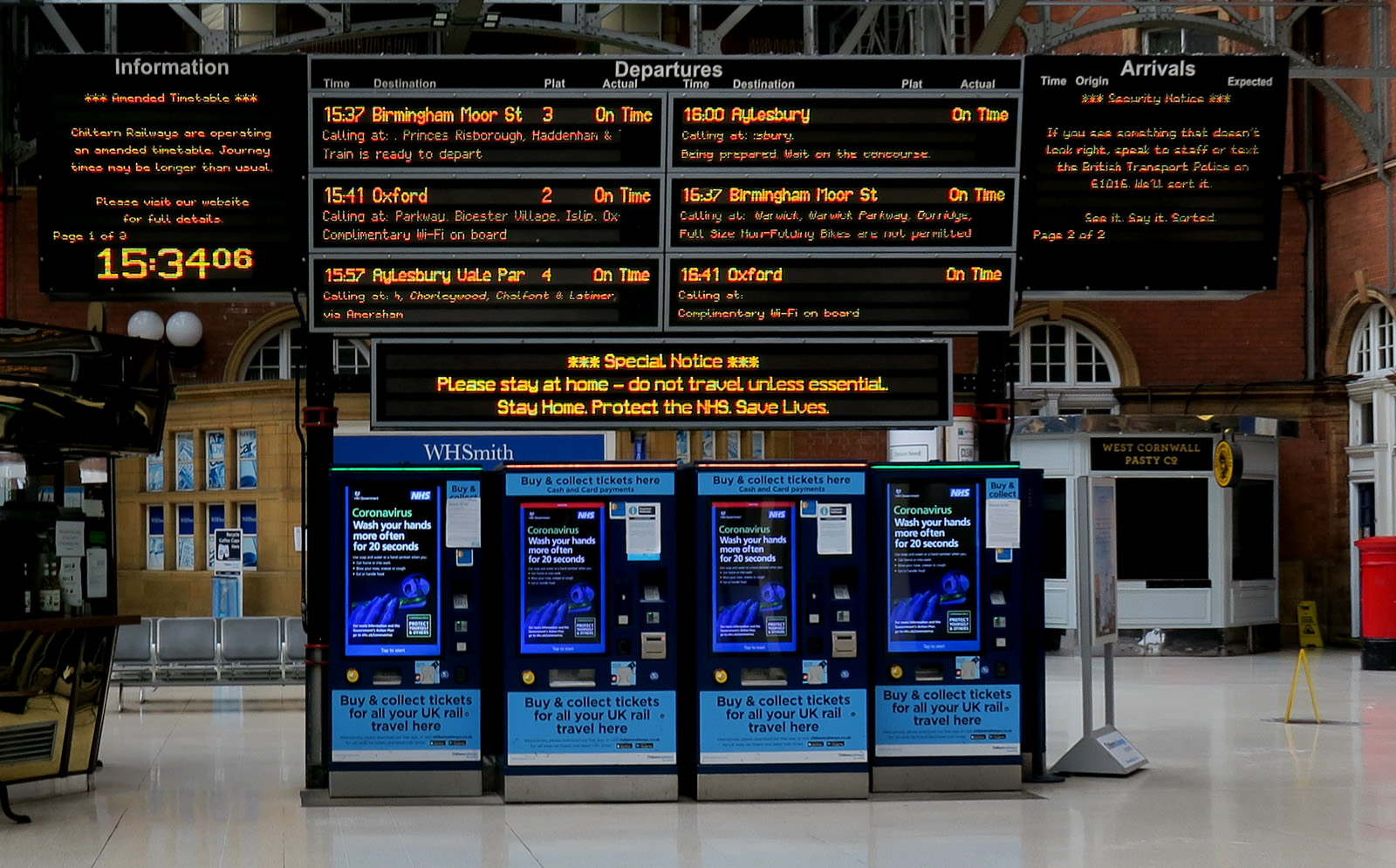 The ERMAs also contain provisions for the replacement of franchises when they come to an end. The precise nature of these will be spelt out in a White Paper, which will respond to the recommendations of the Williams Review of the railways. This review was set up in 2018 in the aftermath of difficulties with various franchises and a chaotic nationwide timetable change. The review’s findings were originally scheduled to be published in Autumn 2019, but were then put back because of the general election and the disruptions caused by the pandemic. The government hopes that it will be published before the end of 2020.
The ERMAs also contain provisions for the replacement of franchises when they come to an end. The precise nature of these will be spelt out in a White Paper, which will respond to the recommendations of the Williams Review of the railways. This review was set up in 2018 in the aftermath of difficulties with various franchises and a chaotic nationwide timetable change. The review’s findings were originally scheduled to be published in Autumn 2019, but were then put back because of the general election and the disruptions caused by the pandemic. The government hopes that it will be published before the end of 2020.
It is expected that the review will recommend replacing the franchise system with something similar to the currents ERMAs. TOCs awarded a contract will be paid a performance-related fee and revenues will go to the government, which will bear the costs. While this is not quite renationalisation, it is not the previous franchise system where TOCs bore the risks. It is in effect a contract system where private companies are paid to deliver a public service.
The CrossCountry franchise
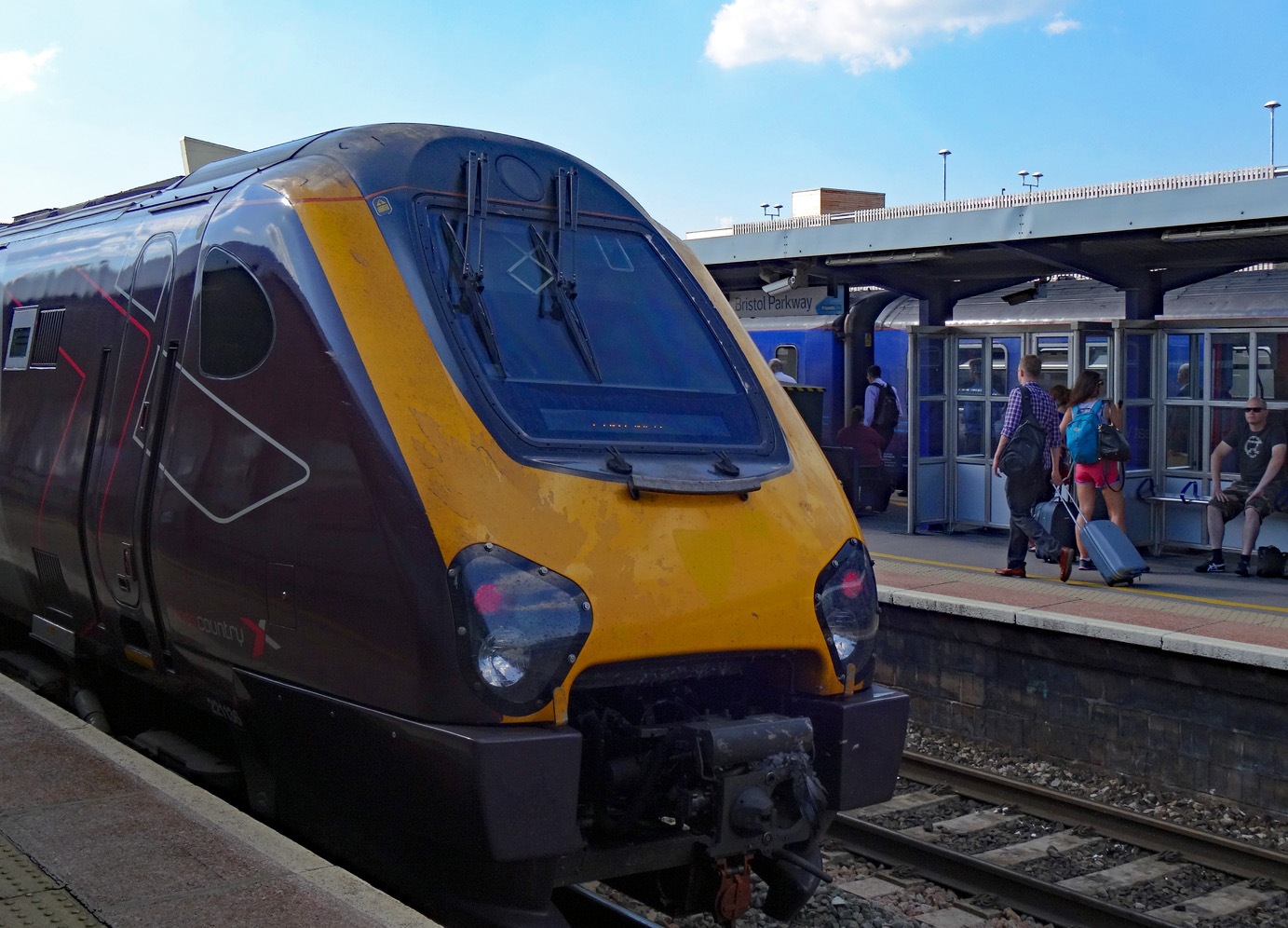 The first test of this new approach to contracting with TOCs came this month. Arriva’s franchise for running CrossCountry trains ran out and was replaced by a three-year contract to run the services, which span
The first test of this new approach to contracting with TOCs came this month. Arriva’s franchise for running CrossCountry trains ran out and was replaced by a three-year contract to run the services, which span  much of the length of Great Britain from Aberdeen to Penzance via Edinburgh, Glasgow, Newcastle, Sheffield, Birmingham, Bristol and Plymouth; from Bournemouth to Manchester via Reading, Oxford, Wolverhampton and Stoke; from Cardiff to Nottingham via Gloucester, Birmingham and Derby; and from Birmingham to Stanstead Airport via Leicester and Cambridge.
much of the length of Great Britain from Aberdeen to Penzance via Edinburgh, Glasgow, Newcastle, Sheffield, Birmingham, Bristol and Plymouth; from Bournemouth to Manchester via Reading, Oxford, Wolverhampton and Stoke; from Cardiff to Nottingham via Gloucester, Birmingham and Derby; and from Birmingham to Stanstead Airport via Leicester and Cambridge.
The contract will last three years. The Department for Transport will gain the revenues and cover the costs and pay Arriva (owned by Deutsche Bahn) a management fee that is ‘performance related’ – as yet unspecified. This, like the EMAs and then the ERMAs, will remove the risks from Arriva.
Nationalisation in Wales
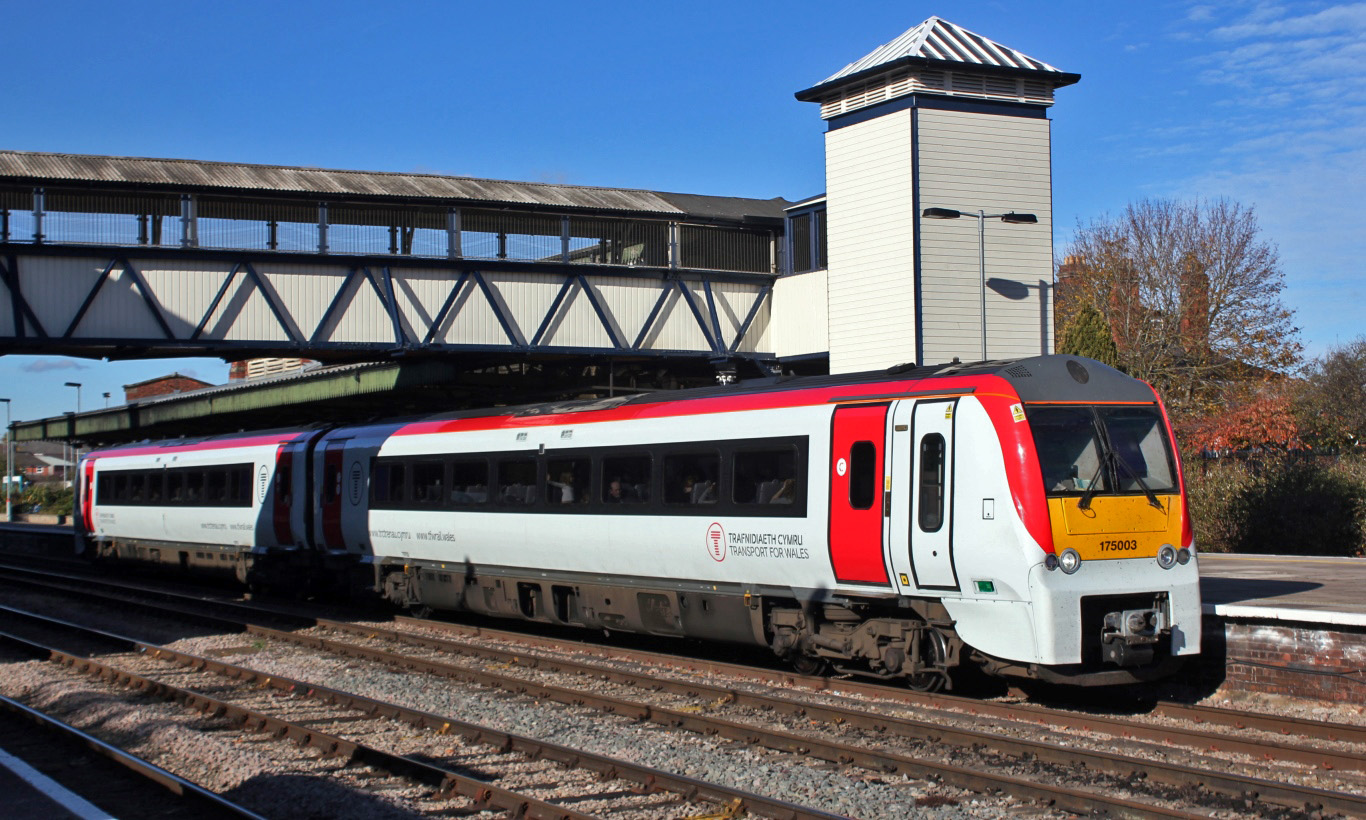 The Welsh government has announced that Transport for Wales will be taken over by a publicly owned company in February 2021. TfW operates many of the routes in Wales and the borders and most of the branch lines in Wales, including the valley commuter lines into Cardiff. It is currently owned by KeolisAmey (a joint company owned 70% by the French company, Keolis (part of SNCF), and 30% by the UK company, Amey), which took over the franchise in 2018 from Arriva. The Welsh government considered that KeolisAmey would collapse if it did not provide support. Ministers decided that nationalisation would give it greater control than simply subsidising KeolisAmey.
The Welsh government has announced that Transport for Wales will be taken over by a publicly owned company in February 2021. TfW operates many of the routes in Wales and the borders and most of the branch lines in Wales, including the valley commuter lines into Cardiff. It is currently owned by KeolisAmey (a joint company owned 70% by the French company, Keolis (part of SNCF), and 30% by the UK company, Amey), which took over the franchise in 2018 from Arriva. The Welsh government considered that KeolisAmey would collapse if it did not provide support. Ministers decided that nationalisation would give it greater control than simply subsidising KeolisAmey.
James Price, chief executive of the Welsh Government, stated that this allows it:
to reduce the profit we pay to the private sector massively over time, and make sure that when the revenue comes back, it comes back in to the taxpayer.
Under emergency measures, KeolisAmey has already been supported by the Welsh government to the tune of £105 million (£40 million in March and £65 million in June) to continue operating the franchise. Passenger numbers fell by 95% as the pandemic hit.
Is nationalisation a better way forward, or should private train operating companies continue with the government taking on the risks, or should the franchise system be amended with greater support from the government but with the TOCs still bearing risk? The articles below consider these issues.
Articles
- Rail nationalisations may be coming down the track
BBC News, Tom Burridge (17/9/20)
- ONS recognises full nationalisation of the UK railways
Financial Times, Tanya Powley (31/7/20)
- Train services are very efficient for shareholders – less so for customers
The Conversation, Daniel Fisher (22/8/19)
- UK government on standby to nationalise more rail lines
Financial Times, Jim Pickard and Philip Georgiadis (17/9/20)
- British Government Ends Rail Franchising
Railway-News, Josephine Cordero Sapién (21/9/20)
- British government announces end for rail franchise system
Trains, Keith Fender (12/10/20)
- Monday essay: A new era?
Railnews, Sim Harris (19/10/20)
- Arriva secures three-year CrossCountry contract
International railway Journal Kevin Smith (16/10/20)
- New contract signed for Arriva CrossCountry
RTM, Ailsa Cowen (16/10/20)
- Franchising is Dead
Railway-News, Josephine Cordero Sapién and Gareth Davies (16/9/20)
- Transport for Wales rail services to be nationalised
BBC News (23/10/20)
- Transport for Wales to be nationalised
Railnews (22/10/20)
- Why has the Welsh Government nationalised rail’s Wales and Borders franchise?
BusinessLive, Sion Barry (22/10/20)
Questions
- Explain how the franchising system worked (prior to March 2020).
- To what extent could each franchise be described as a ‘contestable monopoly’?
- What incentives were built into the franchising system to deliver improvements in service for passengers?
- What were the weaknesses of the franchising system?
- In the context of post-pandemic rail services, compare the relative merits of nationalisation with those of awarding contracts where the government receives the revenues and bears the costs and pays train operating companies a fee for operating the services where the size of the fee is performance related.
- What are the arguments for subsidising rail transport? What should determine the size of the subsidy?
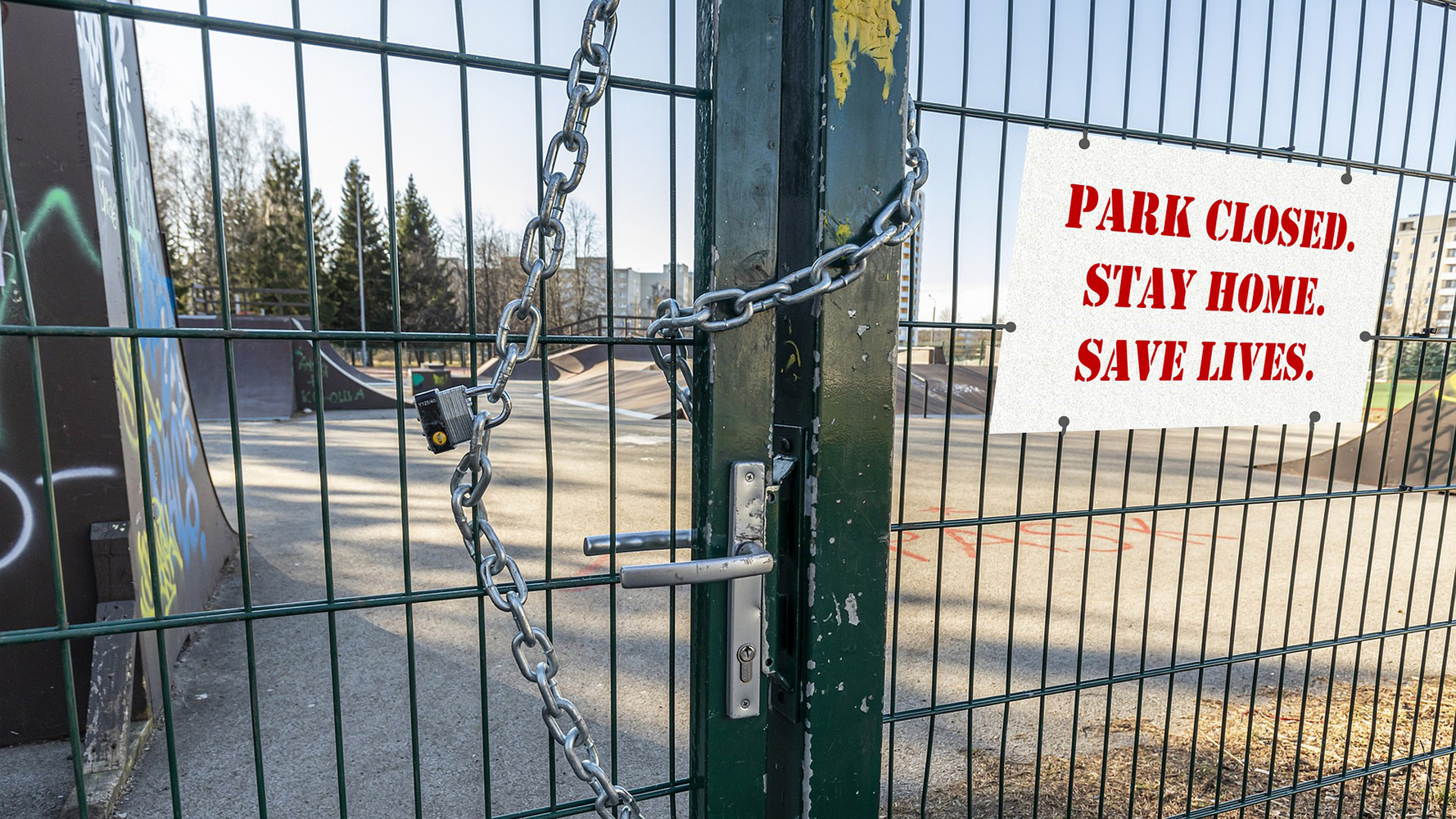 Three international agencies, the IMF, the European Commission and the OECD, all publish six-monthly forecasts for a range of countries. As each agency’s forecasts have been published this year, so the forecasts for economic growth and other macroeconomic indicators, such as unemployment, have got more dire.
Three international agencies, the IMF, the European Commission and the OECD, all publish six-monthly forecasts for a range of countries. As each agency’s forecasts have been published this year, so the forecasts for economic growth and other macroeconomic indicators, such as unemployment, have got more dire.
The IMF was the first to report. Its World Economic Outlook, published on 14 April, forecast that in the UK real GDP would fall by 6.5% in 2020 and rise by 4% in 2021 (not enough to restore GDP to 2019 levels); in the USA it would fall by 5.9% this year and rise by 4.7% next year; in the eurozone it would fall by 7.5% this year and rise by 4.7% next.
The European Commission was next to report. Its AMECO database was published on 6 May. This forecast that UK real GDP would fall by 8.3% this year and rise by 6% next; in the USA it would fall by 6.5% this year and rise by 4.9% next; in the eurozone it would fall by 7.7% this year and rise by 6.3% next.
The latest to report was the OECD on 10 June. The OECD Economic Outlook was the most gloomy. In fact, it produced two sets of forecasts.
The first, more optimistic one (but still more gloomy than the forecasts of the other two agencies) was based on the assumption that lockdowns would continue to be lifted and that there would be no second outbreak later in the year. This ‘single-hit scenario’ forecast that UK real GDP would fall by 11.5% this year and rise by 9% next (a similar picture to France and Italy); in the USA it would fall by 7.3% this year and rise by 4.1% next; in the eurozone it would fall by 9.1% this year and rise by 6.5% next.
The second set of OECD forecasts was based on the assumption that there would be a second wave of the virus and that lockdowns would have to be reinstated. Under this ‘double-hit scenario’, the UK’s GDP is forecast to fall by 14.0% this year and rise by 5.0 per cent next; in the USA it would fall by 8.5% this year and rise by 1.9% next; in the eurozone it would fall by 11.5% this year and rise by 3.5% next.
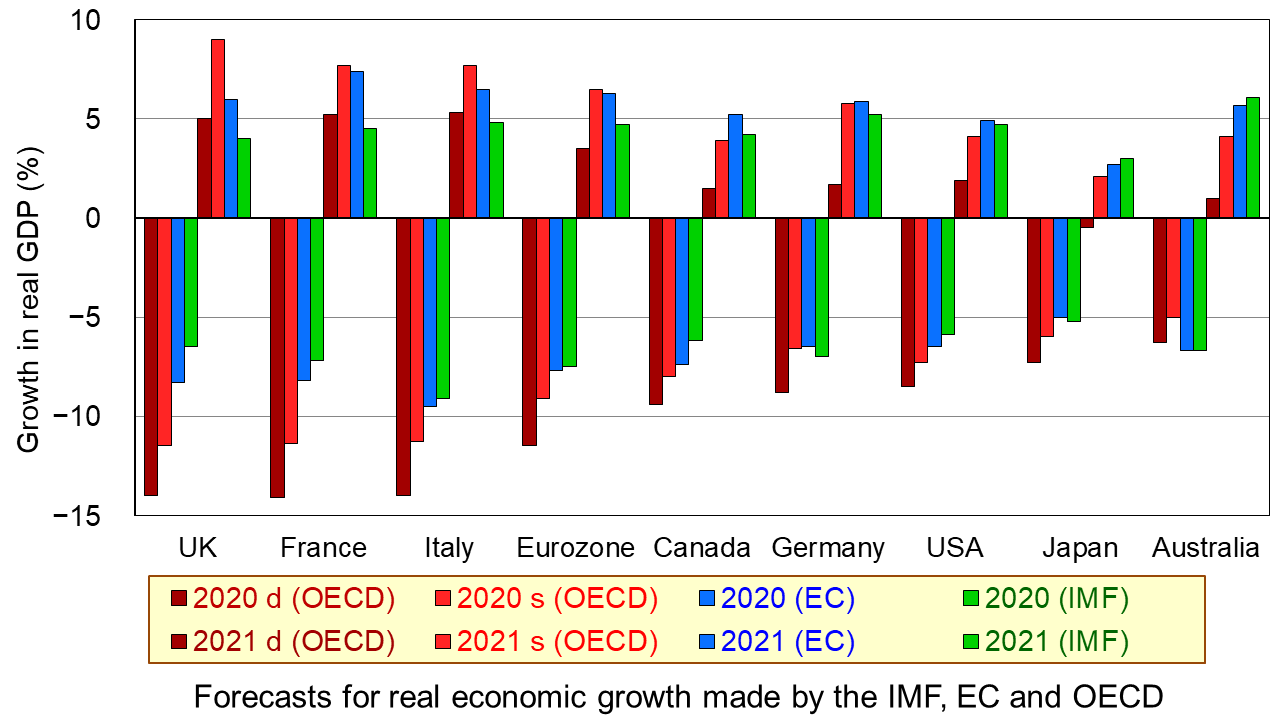
The first chart shows the four sets of forecasts (including two from the OECD) for a range of countries. The first four bars for each country are the forecasts for 2020; the other four bars for each country are for 2021. (Click here for a PowerPoint of the chart.)
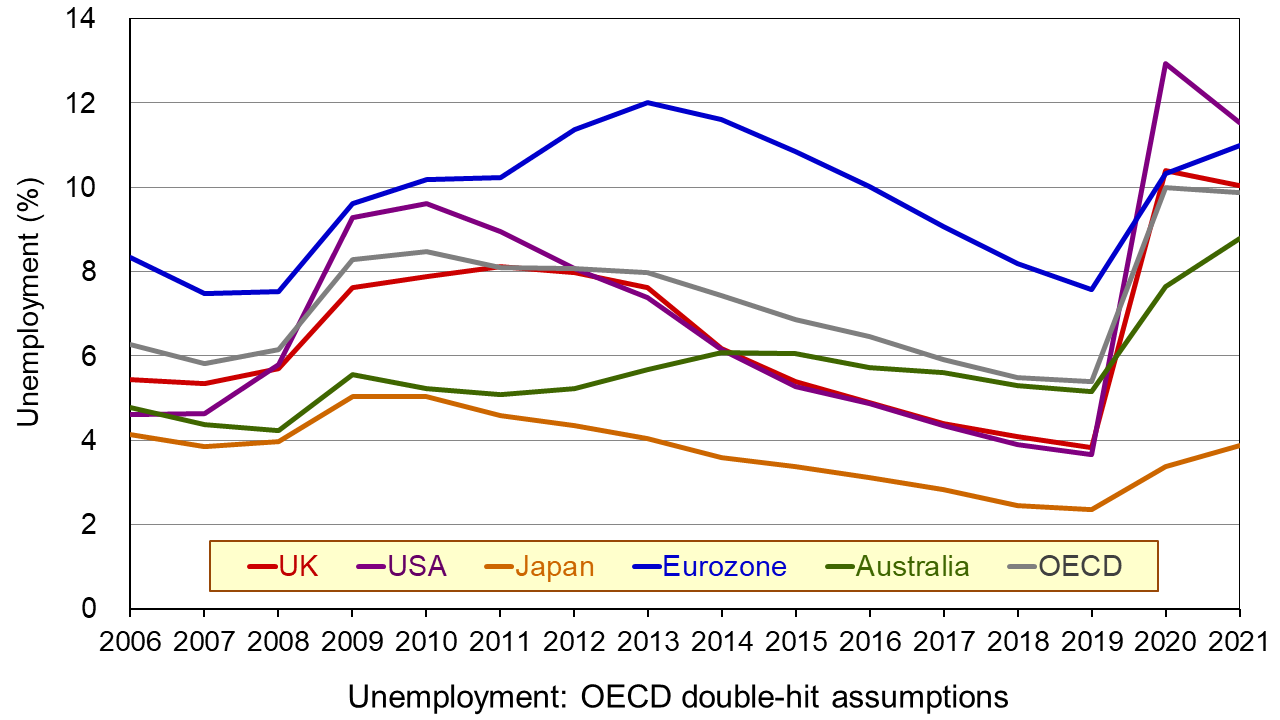
The second chart shows unemployment rates from 2006. The figures for 2020 and 2021 are OECD forecasts based on the double-hit assumption. You can clearly see the dramatic rise in unemployment in all the countries in 2020. In some cases it is forecast that there will be a further rise in 2021. (Click here for a PowerPoint of the chart.)
As the OECD states:
In both scenarios, the recovery, after an initial, rapid resumption of activity, will take a long time to bring output back to pre-pandemic levels, and the crisis will leave long-lasting scars – a fall in living standards, high unemployment and weak investment. Job losses in the most affected sectors, such as tourism, hospitality and entertainment, will particularly hit low-skilled, young, and informal workers.
But why have the forecasts got gloomier? There are both demand- and supply-side reasons.
Aggregate demand has fallen more dramatically than originally anticipated. Lockdowns have lasted longer in many countries than governments had initially thought, with partial lockdowns, which replace them, taking a long time to lift. With less opportunity for people to go out and spend, consumption has fallen and saving has risen. Businesses that have shut, some permanently, have laid off workers or they have been furloughed on reduced incomes. This too has reduced spending. Even when travel restrictions are lifted, many people are reluctant to take holidays at home and abroad and to use public transport for fear of catching the virus. This reluctance has been higher than originally anticipated. Again, spending is lower than before. Even when restaurants, bars and other public venues are reopened, most operate at less than full capacity to allow for social distancing. Uncertainty about the future has discouraged firms from investing, adding to the fall in demand.
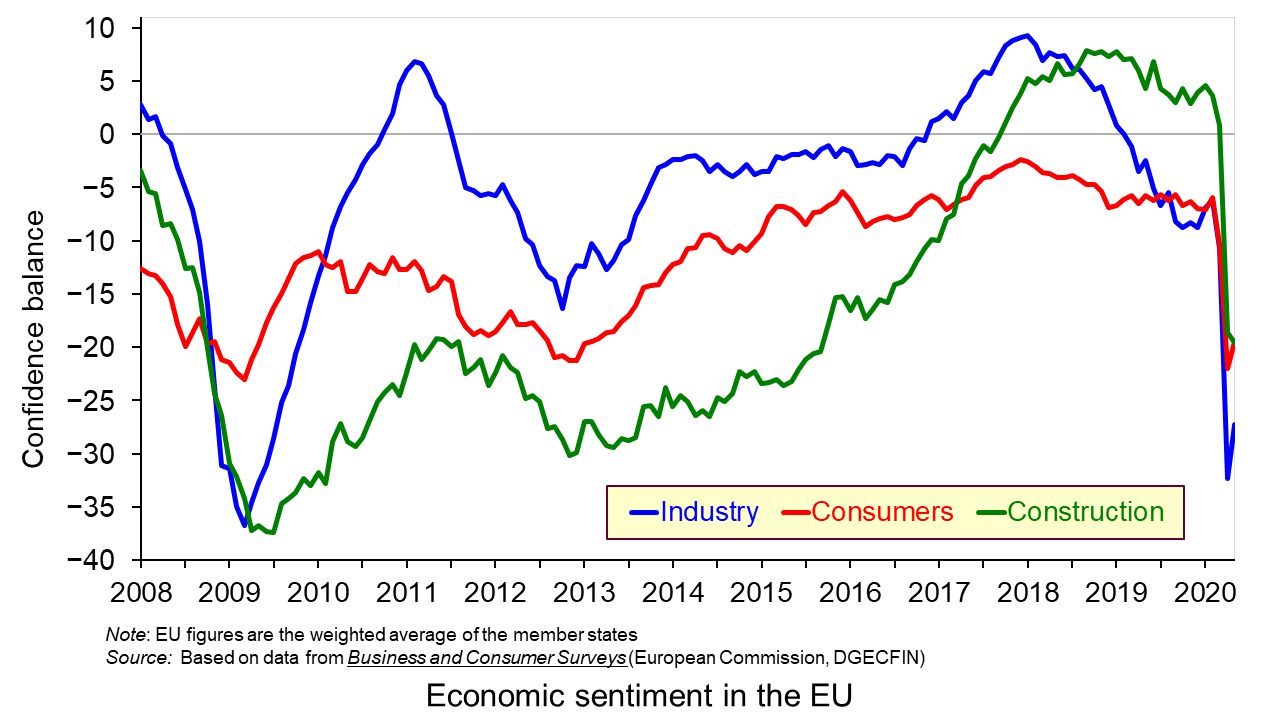
On the supply side, there has been considerable damage to capacity, with firms closing and both new and replacement investment being put on hold. Confidence in many sectors has plummeted as shown in the third chart which looks at business and consumer confidence in the EU. (Click here for a PowerPoint of the above chart.) Lack of confidence directly affects investment with both supply- and demand-side consequences.
Achieving a sustained recovery will require deft political and economic judgements by policymakers. What is more, people are increasingly calling for a different type of economy – one where growth is sustainable with less pollution and degradation of the environment and one where growth is more inclusive, where the benefits are shared more equally. As Angel Gurría, OECD Secretary-General, states in his speech launching the latest OECD Economic Outlook:
The aim should not be to go back to normal – normal was what got us where we are now.
Articles
OECD publications
Questions
- Why has the UK economy been particularly badly it by the Covid-19 pandemic?
- What will determine the size and timing of the ‘bounce back’?
- Why will the pandemic have “dire and long-lasting consequences for people, firms and governments”?
- Why have many people on low incomes faced harsher consequences than those on higher incomes?
- What are the likely environmental impacts of the pandemic and government measures to mitigate the effects?
 The development of open-source software and blockchain technology has enabled people to ‘hack’ capitalism – to present and provide alternatives to traditional modes of production, consumption and exchange. This has enabled more effective markets in second-hand products, new environmentally-friendly technologies and by-products that otherwise would have been negative externalities. Cryptocurrencies are increasingly providing the medium of exchange in such markets.
The development of open-source software and blockchain technology has enabled people to ‘hack’ capitalism – to present and provide alternatives to traditional modes of production, consumption and exchange. This has enabled more effective markets in second-hand products, new environmentally-friendly technologies and by-products that otherwise would have been negative externalities. Cryptocurrencies are increasingly providing the medium of exchange in such markets. The changes are built on new attitudes and new technologies. New attitudes include regarding nature and the land as living resources that need respect. This would involve moving away from monocultures and deforestation and, with appropriate technologies (old and new), could lead to greater output, greater equality within agriculture and increased carbon absorption. The podcast gives examples from the developing and developed world of successful moves towards smaller-scale and more diversified agriculture that are much more sustainable. The rise in farmers’ markets provides an important mechanism to drive both demand and supply.
The changes are built on new attitudes and new technologies. New attitudes include regarding nature and the land as living resources that need respect. This would involve moving away from monocultures and deforestation and, with appropriate technologies (old and new), could lead to greater output, greater equality within agriculture and increased carbon absorption. The podcast gives examples from the developing and developed world of successful moves towards smaller-scale and more diversified agriculture that are much more sustainable. The rise in farmers’ markets provides an important mechanism to drive both demand and supply. These problems were made worse by the response to the financial crisis of 2007–8, when governments chose to save the existing model of capitalism by propping up financial markets through quantitative easing, which massively inflated asset prices and aggravated the problem of inequality. They missed the opportunity of creating money to invest in alternative technologies and infrastructure.
These problems were made worse by the response to the financial crisis of 2007–8, when governments chose to save the existing model of capitalism by propping up financial markets through quantitative easing, which massively inflated asset prices and aggravated the problem of inequality. They missed the opportunity of creating money to invest in alternative technologies and infrastructure. A final hack is one that can directly tackle the problem of externalities – one of the greatest weaknesses of conventional capitalism. New technologies can support ways of rewarding people for reducing external costs, such as paying indigenous people for protecting the land or forests. Carbon markets have been developed in recent years. Perhaps the best example is the European Emissions Trading Scheme (EMS). But so far they have been developed in isolation. If the revenues generated could go directly to those involved in environmental protection, this would help further to internalise the externalities. The podcasts gives an example of a technology used in the Amazon to identify the environmental benefits of protecting rain forests that can then be used to allow reliable payments to the indigenous people though blockchain currencies.
A final hack is one that can directly tackle the problem of externalities – one of the greatest weaknesses of conventional capitalism. New technologies can support ways of rewarding people for reducing external costs, such as paying indigenous people for protecting the land or forests. Carbon markets have been developed in recent years. Perhaps the best example is the European Emissions Trading Scheme (EMS). But so far they have been developed in isolation. If the revenues generated could go directly to those involved in environmental protection, this would help further to internalise the externalities. The podcasts gives an example of a technology used in the Amazon to identify the environmental benefits of protecting rain forests that can then be used to allow reliable payments to the indigenous people though blockchain currencies. Hacking capitalism
Hacking capitalism The coronavirus pandemic and the climate emergency have highlighted the weaknesses of free-market capitalism.
The coronavirus pandemic and the climate emergency have highlighted the weaknesses of free-market capitalism.  At the same time as the world has been grappling with the pandemic, global warming has contributed to extreme heat and wildfires in various parts of the world, such as western North America, the eastern Mediterranean and Siberia, and major flooding in areas such as western Europe and China. Governments again have intervened by providing support to people whose property and livelihoods have been affected. Also there is a growing urgency to tackle global warming, with some movement, albeit often limited, in implementing policies to achieve net zero carbon emissions by some specified point in the future. Expectations are rising for concerted action to be agreed at the international
At the same time as the world has been grappling with the pandemic, global warming has contributed to extreme heat and wildfires in various parts of the world, such as western North America, the eastern Mediterranean and Siberia, and major flooding in areas such as western Europe and China. Governments again have intervened by providing support to people whose property and livelihoods have been affected. Also there is a growing urgency to tackle global warming, with some movement, albeit often limited, in implementing policies to achieve net zero carbon emissions by some specified point in the future. Expectations are rising for concerted action to be agreed at the international  Western governments seem more committed to spending on socially desirable projects, such as transport, communications and green energy infrastructure, education, science and health. They are beginning to pursue more active industrial and regional policies. They are also taking measures to tax multinationals (see the blog
Western governments seem more committed to spending on socially desirable projects, such as transport, communications and green energy infrastructure, education, science and health. They are beginning to pursue more active industrial and regional policies. They are also taking measures to tax multinationals (see the blog  In a series of five podcasts, broadcast on BBC Radio 4 in the first week of January 2021, Amol Rajan and guests examine different aspects of inequality and consider the concept of fairness.
In a series of five podcasts, broadcast on BBC Radio 4 in the first week of January 2021, Amol Rajan and guests examine different aspects of inequality and consider the concept of fairness. The management of rail infrastructure, such as track, signalling and stations, was to be separated from the responsibility for running trains. There would be 25 passenger train operating companies (TOCs), each having a franchise lasting between seven and fifteen years. These companies would have few assets, being forced to rent track and lease stations from the infrastructure owner (Railtrack), and to lease trains and rolling stock from three new rolling-stock companies. …In practice, the 25 franchises were operated by just 11 companies (with one, National Express, having nine of the franchises).
The management of rail infrastructure, such as track, signalling and stations, was to be separated from the responsibility for running trains. There would be 25 passenger train operating companies (TOCs), each having a franchise lasting between seven and fifteen years. These companies would have few assets, being forced to rent track and lease stations from the infrastructure owner (Railtrack), and to lease trains and rolling stock from three new rolling-stock companies. …In practice, the 25 franchises were operated by just 11 companies (with one, National Express, having nine of the franchises). The spread of the coronavirus and the accompanying lockdowns and social distancing saw a plummeting of rail travel. Passenger numbers fell to just 10% of pre-pandemic levels. In March 2020, the UK Government introduced Emergency Measures Agreements (EMAs), which temporarily replaced rail franchise agreements. TOCs were paid a 2% fee (based on pre-Covid costs) to run trains and losses were
The spread of the coronavirus and the accompanying lockdowns and social distancing saw a plummeting of rail travel. Passenger numbers fell to just 10% of pre-pandemic levels. In March 2020, the UK Government introduced Emergency Measures Agreements (EMAs), which temporarily replaced rail franchise agreements. TOCs were paid a 2% fee (based on pre-Covid costs) to run trains and losses were  The ERMAs also contain provisions for the replacement of franchises when they come to an end. The precise nature of these will be spelt out in a White Paper, which will respond to the recommendations of the
The ERMAs also contain provisions for the replacement of franchises when they come to an end. The precise nature of these will be spelt out in a White Paper, which will respond to the recommendations of the  The first test of this new approach to contracting with TOCs came this month. Arriva’s franchise for running CrossCountry trains ran out and was replaced by a three-year contract to run the services,
The first test of this new approach to contracting with TOCs came this month. Arriva’s franchise for running CrossCountry trains ran out and was replaced by a three-year contract to run the services,  much of the length of Great Britain from Aberdeen to Penzance via Edinburgh, Glasgow, Newcastle, Sheffield, Birmingham, Bristol and Plymouth; from Bournemouth to Manchester via Reading, Oxford, Wolverhampton and Stoke; from Cardiff to Nottingham via Gloucester, Birmingham and Derby; and from Birmingham to Stanstead Airport via Leicester and Cambridge.
much of the length of Great Britain from Aberdeen to Penzance via Edinburgh, Glasgow, Newcastle, Sheffield, Birmingham, Bristol and Plymouth; from Bournemouth to Manchester via Reading, Oxford, Wolverhampton and Stoke; from Cardiff to Nottingham via Gloucester, Birmingham and Derby; and from Birmingham to Stanstead Airport via Leicester and Cambridge. The Welsh government has announced that Transport for Wales will be taken over by a publicly owned company in February 2021. TfW operates many of the routes in Wales and the borders and most of the branch lines in Wales, including the valley commuter lines into Cardiff. It is currently owned by
The Welsh government has announced that Transport for Wales will be taken over by a publicly owned company in February 2021. TfW operates many of the routes in Wales and the borders and most of the branch lines in Wales, including the valley commuter lines into Cardiff. It is currently owned by  Three international agencies, the IMF, the European Commission and the OECD, all publish six-monthly forecasts for a range of countries. As each agency’s forecasts have been published this year, so the forecasts for economic growth and other macroeconomic indicators, such as unemployment, have got more dire.
Three international agencies, the IMF, the European Commission and the OECD, all publish six-monthly forecasts for a range of countries. As each agency’s forecasts have been published this year, so the forecasts for economic growth and other macroeconomic indicators, such as unemployment, have got more dire. 

